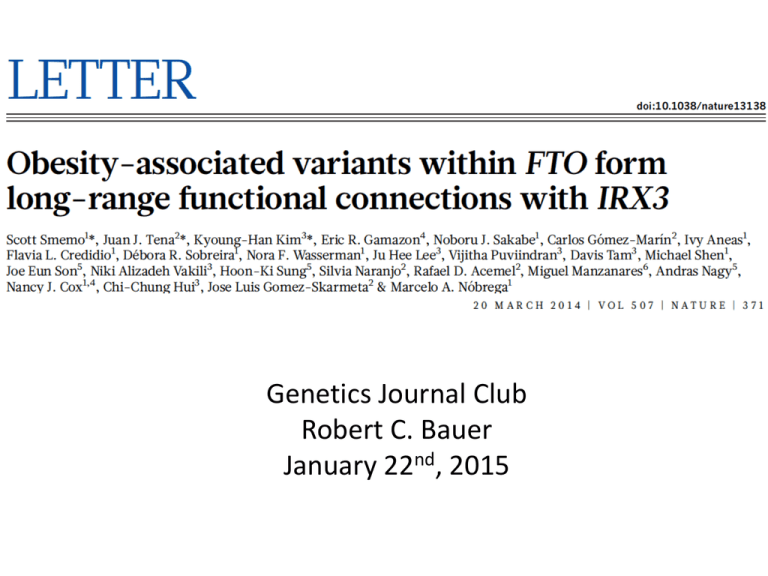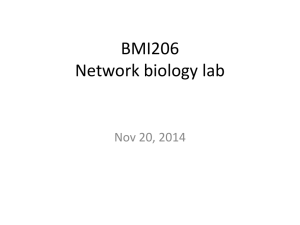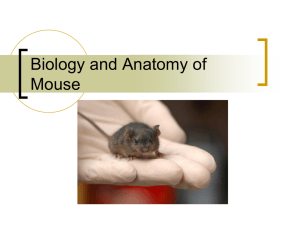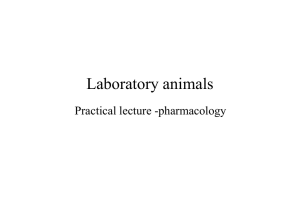Presentation
advertisement

Genetics Journal Club Robert C. Bauer January 22nd, 2015 As of 01/21/15, the catalog includes 2100 publications and 15257 SNPs. How to identify causal gene from a GWAS? Global Lipids Genetics Consortium, Plasma Total Cholesterol Locus GLGC, Nat Genet, 2013 How to identify causal gene from a GWAS? • Closest Gene • Can be challenging with intergenic loci with many genes • Most logical gene based on ontology/known function • Lots of completely unannotated genes • In Vitro assays – overexpression/Knockdown • Cell type specific? • Viral Somatic Overexpression • Is tissue readily accessible • KO Animal Models • Costly to do multiple genes in mice • Zebrafish allow faster testing, may not recapitulate mammals • False Positives/Negatives GLGC, Nat Genet, 2013 SNPs in the FTO genic region associate with Obesity, BMI, and Type-2 Diabetes Obesity Plot Giant Consortium, 2013 (From LocusZoom) GWAS Identifying the FTO locus • SNPs in FTO locus associate with BMI and T2D (mediated by BMI) • Adults homozygous for risk alleles weighed +3kg • SNPs in first intron of FTO associate with early onset obesity in both children and adults • SNPs in first intron of FTO associate with BMI, hip circumference, and weight • Homozygotes for the minor allele are 1.3 BMI units heavier FTO knockout mouse has reduced body weight Fischer et al, Nature, 2009 FTO transgenic mouse has INCREASED body weight in a dose dependent manner Church et al., Nature Genet, 2010 Multiple Mouse Models support role for FTO in obesity Mouse model Body weight Fat/lean mass Energy expenditure Food intake Reference Knockout Decreased Decreased Increased Increased Fischer, J. et al Nature 2009 Knockout Decreased Decreased Increased Not affected Church, C et al Plos Genet 2009 Overexpression Increased Increased Not affected Increased Church, C. et al.Nature Genet 2010 Knockout Decreased Not affected Increased Increased Gao, X. et al. PLoS ONE 2010 Neural specific KO Decreased Not affected Increased Increased Gao, X. et al. PLoS ONE 2010 The case against FTO – no eQTL Wahlen et al., J Lipid Res, 2008 Grunnet et al., Diabetes, 2009 IS FTO THE GENE??? LD Block defines FTO “Association Interval” Extended Data Figure 5. Human HapMap II Data Circular Chromosome Conformation Capture (4C)-Seq Stadhouders R et al. Nat Protoc. 2013 Figure 1A: The Association Interval physically interacts with promoter of Irx3 in Fetal Mouse ED Fig. 1B: The Association Interval exclusively interacts with promoter of Irx3 in adult mouse brain ED Fig. 2B: The IRX3 interaction replicates in human fibroblasts via Hi-C • Also replicated in ENCODE ChIA-PET data in MCF-7 cells • Another replication in zebrafish embryos by 4C Fig 1B: The Association Interval contains features of enhancer elements In Vivo Enhancer Reporter Irx3 LacZ Knock-In ED Fig 3: IRX3 promoter alone cannot recapitulate expression patterns while FTO promoter can. • BAC with 162kb fragment of human FTO locus and Association Interval Fig 2A: BMI associated SNPs have eQTL with IRX3 in human brain • No SNPs showed association with FTO expression Fig 2: IRX3 eSNPs are associated with BMI in brain but not adipose Fig 3: Irx3 KO mice have decreased Body weight and adipocity Fig 3: Irx3 KO mice have decreased adipocyte size, are glucose tolerant and insulin sensitive Fig 3: Irx3 KO mice have increased energy expenditure and browning of WAT Fig 3: Irx3 is expressed in mouse hypothalamus Fig 4: Expression of DN Irx3 in hypothalamus phenocopies Irx3 KO mouse Fig 4: Loss of Irx3 function in hypothalamus causes browning of WAT SUMMARY • Irx3 promoter interacts with the obesity-associated interval – over 400kb away • Obesity associated interval contains enhancer elements with activity pattern similar to Irx3 • BMI associated SNPs in the interval are associated with Irx3 expression level in human brain • Irx3 knockout mice have a lean phenotype and higher energy expenditure which can be recapitulated by hypothalamus specific disruption of Irx3 function COMMENTS • Mouse models not sufficient for validation of GWAS loci? “We searched among 7,556 targeted mouse gene knockout models for evidence of alterations in body size, mass and growth (see Methods). Nearly one-third (2,166; 29%) of gene knockouts in mice show alteration of these phenotypes, underscoring that animal models alone are not sufficient to definitively establish a functional relationship between a given gene and long-range noncoding variants (Supplementary Table 4).” GWAS Signal for Coronary Artery Diseases in ADAMTS7/MORF4L1 locus Adamts7 KO mice have reduced atherosclerosis COMMENTS • Mouse models not sufficient for validation of GWAS loci? • Power of GWAS in identifying novel biology FTO: Nuclear whose exact physiological is not known. Proteins with smiliar homology participate in oxidative demethylation of damaged DNA/RNA. IRX3: Member of the Iroquois homeobox gene family involved in early steps of neural development. Members of this family appear to play multiple roles during pattern formation of vertebrate embryos. NEITHER GENE IMPLICATED IN OBESITY PRIOR TO THESE STUDIES COMMENTS • Mouse models not sufficient for validation of GWAS loci? • Power of GWAS in identifying novel biology • Irx3 KO mouse – show the KO?? COMMENTS • • • • Mouse models not sufficient for validation of GWAS loci? Power of GWAS in identifying novel biology Irx3 KO mouse – show the KO?? Mechanism? Known hormones that regulate metabolism?







